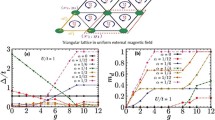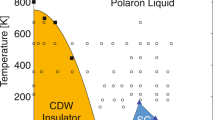Abstract
Recent investigations suggest that both spin-orbit coupling and electron correlation play very crucial roles in the 5d transition metal oxides. By using the generalized Gutzwiller variational method and dynamical mean-field theory with the hybridization expansion continuous time quantum Monte Carlo as impurity solver, the three-band Hubbard model with full Hund’s rule coupling and spin-orbit interaction terms, which contains the essential physics of partially filled t 2g sub-shell of 5d materials, is studied systematically. The calculated phase diagram of this model exhibits three distinct phase regions, which are metal, band insulator and Mott insulator. We find that the spin-orbit coupling term tends to greatly enhance the tendency towards the Mott insulator phase. Furthermore, the influence of the electron-electron interaction on the effective strength of spin-orbit coupling in the metallic phase is studied in detail. We conclude that the electron correlation effect on the effective spin-orbit coupling is far beyond the mean-field treatment even in the intermediate coupling region.
Similar content being viewed by others
References
M. Imada, A. Fujimori, Y. Tokura, Rev. Mod. Phys. 70, 1039 (1998)
A. Georges, G. Kotliar, W. Krauth, M.J. Rozenberg, Rev. Mod. Phys. 68, 13 (1996)
G. Kotliar, S.Y. Savrasov, K. Haule, V.S. Oudovenko, O. Parcollet, C.A. Marianetti, Rev. Mod. Phys. 78, 865 (2006)
L. de’ Medici, J. Mravlje, A. Georges, Phys. Rev. Lett. 107, 256401 (2011)
L. de’ Medici, S.R. Hassan, M. Capone, X. Dai, Phys. Rev. Lett. 102, 126401 (2009)
P. Werner, A.J. Millis, Phys. Rev. Lett. 99, 126405 (2007)
T. Kita, T. Ohashi, N. Kawakami, Phys. Rev. B 84, 195130 (2011)
B.J. Kim, H. Jin, S.J. Moon, J.Y. Kim, B.G. Park, C.S. Leem, J. Yu, T.W. Noh, C. Kim, S.J. Oh, J.H. Park, V. Durairaj, G. Cao, E. Rotenberg, Phys. Rev. Lett. 101, 076402 (2008)
D. Pesin, L. Balents, Nat. Phys. 6, 376 (2010)
B.J. Kim, H. Ohsumi, T. Komesu, S. Sakai, T. Morita, H. Takagi, T. Arima, Science 323, 1329 (2009)
H. Watanabe, T. Shirakawa, S. Yunoki, Phys. Rev. Lett. 105, 216410 (2010)
G. Jackeli, G. Khaliullin, Phys. Rev. Lett. 102, 017205 (2009)
M. Bremholm, S.E. Dutton, P.W. Stephens, R.J. Cava, J. Solid State Chem. 184, 601 (2011)
J. Bünemann, W. Weber, F. Gebhard, Phys. Rev. B 57, 6896 (1998)
J. Bünemann, F. Gebhard, T. Ohm, S. Weiser, W. Weber, Phys. Rev. Lett. 101, 236404 (2008)
N. Lanatà, H.U.R. Strand, X. Dai, B. Hellsing, Phys. Rev. B 85, 035133 (2012)
XiaoYu Deng, Lei Wang, Xi Dai, Zhong Fang, Phys. Rev. B 79, 075114 (2009)
P. Werner, A. Millis, Phys. Rev. B 74, 1 (2006)
E. Gull, A.J. Millis, A.I. Lichtenstein, A.N. Rubtsov, M. Troyer, P. Werner, Rev. Mod. Phys. 83, 349 (2011)
W. Metzner, D. Vollhardt, Phys. Rev. Lett. 59, 121 (1987)
W. Metzner, D. Vollhardt, Phys. Rev. B 37, 7382 (1988)
M.C. Gutzwiller, Phys. Rev. Lett. 10, 159 (1963)
M.C. Gutzwiller, Phys. Rev. 134, A923 (1964)
M.C. Gutzwiller, Phys. Rev. 137, A1726 (1965)
Li Huang, Liang Du, Xi Dai, Phys. Rev. B 86, 035150 (2012)
A. Liebsch, Phys. Rev. Lett. 91, 226401 (2003)
Li Huang, Yilin Wang, Xi Dai, Phys. Rev. B 85, 245110 (2012)
Guo-Qiang Liu, V.N. Antonov, O. Jepsen, O.K. Andersen, Phys. Rev. Lett. 101, 026408 (2008)
A. Subedi, Phys. Rev. B 85, 020408 (2012)
Author information
Authors and Affiliations
Corresponding author
Rights and permissions
About this article
Cite this article
Du, L., Huang, L. & Dai, X. Metal-insulator transition in three-band Hubbard model with strong spin-orbit interaction. Eur. Phys. J. B 86, 94 (2013). https://doi.org/10.1140/epjb/e2013-31024-6
Received:
Revised:
Published:
DOI: https://doi.org/10.1140/epjb/e2013-31024-6




